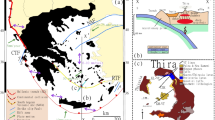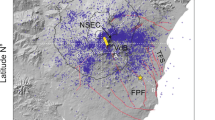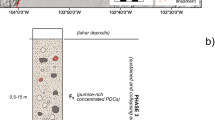Abstract
Many basaltic and andesitic polygenetic volcanoes have cyclic eruptive activity that alternates between a phase dominated by flank eruptions and a phase dominated by eruptions from a central vent. This paper proposes the use of time-series diagrams of eruption sites on each polygenetic volcano and intrusion distances of dikes to evaluate volcano growth, to qualitatively reconstruct the stress history within the volcano, and to predict the next eruption site. In these diagrams the position of an eruption site is represented by the distance from the center of the volcano and the clockwise azimuth from north. Time-series diagrams of Mauna Loa, Kilauea, Kliuchevskoi, Etna, Sakurajima, Fuji, Izu-Oshima, and Hekla volcanoes indicate that fissure eruption sites of these volcanoes migrated toward the center of the volcano linearly, radially, or spirally with damped oscillation, occasionally forming a hierarchy in convergence-related features. At Krafla, terminations of dikes also migrated toward the center of the volcano with time. Eruption sites of Piton de la Fournaise did not converge but oscillated around the center. After the convergence of eruption sites with time, the central eruption phase is started. The intrusion sequence of dikes is modeled, applying crack interaction theory. Variation in convergence patterns is governed by the regional stress and the magma supply. Under the condition that a balance between regional extension and magma supply is maintained, the central vent convergence time during the flank eruption phase is 1–10 years, whereas the flank vent recurrence time during the central eruption phase is greater than 100 years owing to an inferred decrease in magma supply. Under the condition that magma supply prevails over regional extension, the central vent convergence time increases, whereas the flank vent recurrence time decreases owing to inferred stress relaxation. Earthquakes of M≥6 near a volcano during the flank eruption phase extend the central vent convergence time. Earthquakes during the central eruption phase promote recurrence of flank eruptions. Asymmetric distribution of eruption sites around the flanks of a volcano can be caused by local stress sources such as an adjacent volcano.
Similar content being viewed by others
Author information
Authors and Affiliations
Additional information
Received: 18 March 1996 / Accepted: 14 January 1997
Rights and permissions
About this article
Cite this article
Takada, A. Cyclic flank-vent and central-vent eruption patterns. Bull Volcanol 58, 539–556 (1997). https://doi.org/10.1007/s004450050161
Issue Date:
DOI: https://doi.org/10.1007/s004450050161




